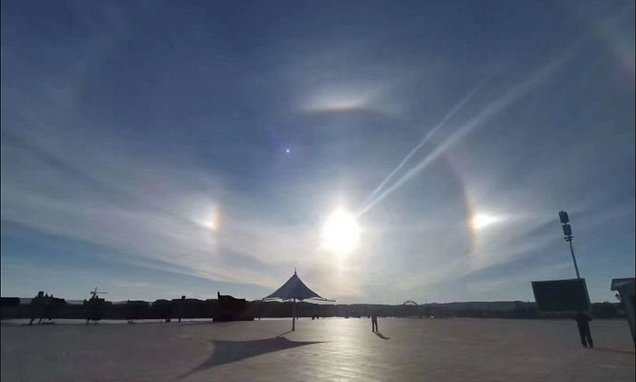You are using an out of date browser. It may not display this or other websites correctly.
You should upgrade or use an alternative browser.
You should upgrade or use an alternative browser.
SOTT monthly Earth Changes Summary video suggestions
- Thread starter treesparrow
- Start date
Severe floods hit Monteforte Irpino, Italy - Sept 27
Last edited:
Storm Alex lashes southern France, Italy - 3 Oct 2020 -
Heavy snowfall in Livigno, Italy - 5 Oct -
Heavy snowfall in Livigno, Italy - 5 Oct -
Last edited:
Tornado in Belgium Oct 5 -
A parhelion - sun dog, captured in southern Germany, Oct 4th -
Wet micro burst over Lake Millstatt in Austria, Oct 3 -
A parhelion - sun dog, captured in southern Germany, Oct 4th -
Wet micro burst over Lake Millstatt in Austria, Oct 3 -
Fireball information at 1 o'clock this morning (before dawn on 10/11). By the way, looking at the data such as radiant points, it is an area where meteor shower activity is likely, but it is not clear.
T-2
A big fireball ran this morning. It looks like a large fireball that flowed at 1:00 on October 11, 2020 was seen with a wide-angle camera from Hiratsuka to the north. Simultaneous meteor sounds were also captured, and a beep sound was heard when the light began to shine, and a bang sound was heard when it became brightest. The Taurus South Meteor Shower has reached its maximum, but it seems that it was a scattered meteor fireball.
Video Sun Halo over Pangody
7:47 PM · Oct 8, 2020
T-2
A big fireball ran this morning. It looks like a large fireball that flowed at 1:00 on October 11, 2020 was seen with a wide-angle camera from Hiratsuka to the north. Simultaneous meteor sounds were also captured, and a beep sound was heard when the light began to shine, and a bang sound was heard when it became brightest. The Taurus South Meteor Shower has reached its maximum, but it seems that it was a scattered meteor fireball.
Video Sun Halo over Pangody
7:47 PM · Oct 8, 2020
11-12 October
Two bright meteors overflew the south of Spain on October 11-12. The first of them was spotted on October 11 at about 21:37 local time (equivalent to 19:37 universal time). It was generated by a rock (a meteoroid) from an asteroid that hit the atmosphere at around 58,000 km/h. It began at an altitude of about 84 km over the province of Córdoba, and ended at a height of around 37 km. The second fireball was recorded on October 12 at about 1:59 local time (equivalent to 23:59 universal time on October 11). It was generated by a meteoroid from a comet that hit the atmosphere at about 86,000 km/h. It began at an altitude of around 101 km over the province of Jaén, and ended at a height of about 73 km over the province of Granada.
October 15 - 'Three suns' appear in the sky of China's northernmost city
Two videos:

 www.dailymail.co.uk
www.dailymail.co.uk

 www.dailymail.co.uk
www.dailymail.co.uk
Two videos:

'THREE SUNS' appear in the sky of a Chinese city for hours
The spectacle lasted three hours this morning in Mohe, the northernmost city of China. It is caused by a natural phenomenon called 'sun dogs' and rarely happens in the country.

'THREE SUNS' appear in the sky of a Chinese city for hours
The spectacle lasted three hours this morning in Mohe, the northernmost city of China. It is caused by a natural phenomenon called 'sun dogs' and rarely happens in the country.
17 October, bright meteor over Puerto Rico
Translated with deepl
A very bright meteor was visible from all over the island at about 3:44 a.m. on Saturday, October 17, 2020, reported the Caribbean Astronomical Society (CAS). "It was a space rock probably several feet in diameter disintegrating through the atmosphere," said Eddie Irizarry, vice president of the organization, noting that the meteor left a remarkable trail of smoke, which gradually dissipated over the course of half an hour.
"At first it looked blue-green, and then somewhat orange, suggesting that the composition of the space rock was possibly magnesium and sodium," he said.
The SAC detailed that the enormous bolide was visible in a westerly direction, but was on a trajectory that suggests it was moving over the Mona Canal towards Desecheo, that is, north.
"Its brightness or intensity of light was of such magnitude that the images captured by one of our cameras looking at the sky to the opposite side (East), show that the meteor illuminated the entire sky for a few moments, and turned the night into day," the educational entity said.
Irizarry indicated that after analyzing the area of the sky where the meteor appeared, it cannot be ruled out that it is a Taurid meteor. "There are several details that suggest it is part of the Taurids, and although they are supposed to be caused by particles from comet 2P/Encke, in recent years something of great interest to scientists has been discovered," he added.
He noted that in recent years, several extremely bright Taurid meteors have been detected, and studies suggest that some have been caused by space rocks between 3 and 30 feet (almost 1 to 9 meters) in diameter.
The findings indicate that the debris area caused by these particular meteors appears to contain not only cometary particles, but also some somewhat large rocks.
In fact, to the scientists' surprise, a couple of rocks between 656 and 984 feet (200 to 300 meters) in diameter were detected in that zone, such as the asteroids named 2005 UR and 2015 TX24.
Although these asteroids do not have a trajectory with risk of impact to our planet, what these studies suggest is that the zone that produces the Taurids, could have some rocks that cause sometimes the sighting of some quite brilliant meteor, like this one that was observed from the Island on October 17.
"Fortunately our atmosphere disintegrates a great part of these, so it is just another interesting aspect of nature, and as long as no really big rock with a dangerous trajectory is detected, it should not be a cause for concern. On the contrary, it is another reason to appreciate the sky", concluded the educational entity.
Translated with deepl
Tornado in Kropyvnytskyi, Ukraine - Oct 17 -
Roll cloud over Lake Michigan - Oct 16 -
Roll cloud over Lake Michigan - Oct 16 -
Landslide after heavy rain in Meishan City, China Oct 19 -
Tall waterspout in Kolymbia, Rhodes, Greece - 21 Oct -
A sign of the times!
If that isn't a sign of the times I don't know what is. A tornado has hit Beirut almost pinpointing the epicenter of the explosion.

Tornado hits Beirut Port, near explosion site
First rains of the season in Lebanon bring along frightening whirlwinds to the destroyed Beirut port area. Some viral videos are circulating on the web of the whirlwind/tornado at the site of the explosion at Beirut Port. On 4 August 2020, a...www.sott.net
Fireballs seen at Brasil
26 October
19 October
18-19 October
10 October
26 October
Fireball was seen in several cities of Bahia on the night of October 26, 2020, and was registered in 2 Live Climate cameras in Ipirá and Itaberaba in Bahia.
19 October
Beautiful fireball seen on the night of October 19 in Bahia and registered by Live Clima ao Vivo
18-19 October
Two fireballs registered in the skies of Mato Grosso and São Paulo. The first in the early evening of October 18, 2020, and the second in the early morning of the 19th.
10 October
Saturday, October 10, in Ceará. From several parts of the state and even from Rio Grande do Norte, there were several reports of sightings of the phenomenon and also of the occurrence of a strong bang followed by tremors on walls and windows in places around Maçico do Baturité.
The meteor was recorded by the geostationary satellite GOES-16 and by a live weather camera. A resident of Redemption recorded the trail of smoke left in the sky by the meteor.
